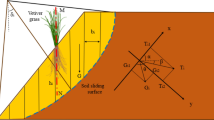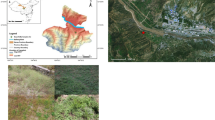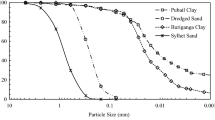Abstract
In areas with similar soil properties and geomorphological conditions, different land uses could promote or reduce the failure probability towards shallow landslides, especially due to differences in the reinforcement acted in the soil by plant roots. In this paper, root density, mechanical properties, and reinforcement provided by different land use types (sowed grasses used to produce animal feed, vineyards cultivated with different agronomical management practices, shrublands, woodlands of broadleaved species) of a representative area of northern Italian Apennines (Oltrepò Pavese hilly sector) were quantified and inserted into a slope stability model to estimate the effects of different land uses on shallow landslide failure probability. Root reinforcement is correlated proportionally to root density in soil and root mechanical properties. Furthermore, a greater root reinforcement in the soil guarantees a lower failure probability of a slope. Sowed grasses and shrublands in abandoned areas are the most land uses which are more prone to shallow landsliding, followed by vineyards with tilled inter-rows. Vineyards with permanent grass cover or alternation in the inter-rows and woodlands promote the stability of slopes in a wide range of steepness (> 21–25° for vineyards with permanent grass cover in the inter-rows, 28–33° for vineyards with alternation in the inter-rows and woodlands). According to these results, possible land use managements acting as mitigation measures for shallow landslides could be implemented.











Similar content being viewed by others
References
Ardenghi NMG, Polani F (2016) La flora della provincia di Pavia (Lombardia, Italia settentrionale). 1. L’Oltrepò Pavese. Atti Soc it Sci nat Museo civ Stor nat Milano 3(2):51–79
Bartelletti C, Giannecchini R, D’Amato Avanzi G, Galanti Y, Mazzali A (2017) The influence of geological–morphological and land use settings on shallow landslidesin the Pogliaschina T. basin (northern Apennines, Italy). J Maps 13(2):142–152
Begueria S (2006) Changes in land cover and shallow landslide activity: a case study in the Spanish Pyrenees. Geomorphology 74(1–4):196–206
Bischetti GB, Chiaradia E, Epis T, Morlotti E (2009) Root cohesion of forest species in the Italian Alps. Plant Soil 324:71–89
Bischetti GB, Bassanelli C, Chiaradia EA, Minotta G, Vergani C (2016) The effect of gap openings on soil reinforcement in two conifer stands in northern Italy. Forest Ecol Manag 359:286–299
Bohm W. (1979) Methods of studying root systems. In: ecological studies. Springer, Berlin, (Germany), pp. 33
Boldrin D, Leung AK, Bengough AG (2017) Correlating hydrologic reinforcement of vegetated soil with plant traits during establishment of woody perennials. Plant Soil 416:437–451
Bordoni M, Meisina C, Valentino R, Bittelli M, Chersich S (2015) Site-specific tolocal-scale shallow landslides triggering zones assessment using TRIGRS. Nat Hazards Earth Syst Sci 15:1025–1050
Bordoni M, Meisina C, Vercesi A et al (2016) Quantifying the contribution of grapevine roots to soil mechanical reinforcement in an area susceptible to shallow landslides. Soil Tillage Res 163:195–206
Bordoni M, Vercesi A, Maerker M et al (2019) Effects of viticulture soil management on the characteristics of soils and roots in the lower Oltrepò Apennines (Lombardy, Italy). Sci Total Environ 693:133390
Brambilla M, Casale F, Bergero V, Bogliani G, Crovetto GM, Falco R, Roati M, Negri I (2010) Glorious past, uncertain present, bad future? Assessing effects of land-use changes on habitat suitability for a threatened farmland bird species. Biodivers Conserv 143:2770–2778
Caparrini F, Manzella F (2009) Hydrometeorological and vegetation indices for the drought monitoring system in Tuscany region, Italy. Adv Geosci 17:105–110
Cascini L, Sorbino G, Cuomo S, Ferlisi S (2014) Seasonal effects of rainfall on the shallow pyroclastic deposits of the Campania region (southern Italy). Landslides 11:779–792
Cavinato GP, De Celles PG (1999) Extensional basins in the tectonically bimodal central Apennines fold-thrust belt, Italy: response to corner flow above a subducting slab in retrograde motion. Geol 27(10):955–958
Celette F, Gaudin R, Gary C (2008) Spatial and temporal changes to the water regime of a Mediterranean vineyard due to the adoption of cover cropping. Eur J Agron 29:153–162
Cevasco A, Pepe G, Brandolini P (2014) The influences of geological and land use settings on shallow landslides triggered by an intense rainfall event in a coastal terraced environment. Bull Eng Geol Environ 73:859–875
Chiaradia EA, Vergani C, Bischetti GB (2016) Evaluation of the effects of three European forest types on slope stability by field and probabilistic analyses and their implications for forest management. Forest Ecol Manag 370:114–129
Ciabatta L, Camici S, Brocca L, Ponziani F, Stelluti M, Berni N, Moramarco T (2016) Assessing the impact of climate-change scenarios on landslide occurrence in Umbria region, Italy. J Hydrol 541A:285–295
Cislaghi A, Bordoni M, Meisina C, Bischetti GB (2017a) Soil reinforcement provided by the root system of grapevines: quantification and spatial variability. Ecol Eng 109:169–185
Cislaghi A, Chiaradia EA, Bischetti GB (2017b) Including root reinforcement variability in a probabilistic 3D stability model. Earth Surf Process Landf 42:1789–1806
Ciurleo M, Calvello M, Cascini L (2016) Susceptibility zoning of shallow landslides in fine grained soils by statistical methods. Catena 139:250–264
Cohen D, Schwarz M, Or D (2011) An analytical fiber bundle model for pullout mechanics of root bundles. J Geophys Res 116:F03010
Cohen D, Schwarz M (2017) Tree-root control of shallow landslides. Earth Surf Dynam 5:451–477
Costantini EAC, Agnelli AE, Fabiani A et al (2015) Short-term recovery of soil physical, chemical, microand mesobiological functions in a new vineyard under organic farming. Soil 1:443–457
Cruden DM Varnes DJ (1996) Landslide types and processes, in: Landslides: investigation and mitigation, edited by: turner, A. K. and Schuster, R. L., National Academy Press, Washington, D.C., 36–75, 1996
Dazio E, Conedera M, Schwarz M (2018) Impact of different chestnut coppice managements on root reinforcement and shallow landslide susceptibility. Forest Ecol Manag 417:63–76
De Baets S, Poesen J, Reubens B et al (2008) Root tensile strength and root distribution of typical Mediterranean plant species and their contribution to soil shear strength. Plant Soil 305:207–226
Dietrich WE, McKean J, Bellugi D, Perron T (2008) The prediction of shallow landslide location and size using a multidimensional landslide analysis in a digital terrain model. In: Chen, C.L., Major, J.J. (Eds.), Proc. Fourth Int. Conf. Debris-Flow Hazard Mitig.: Mech., Predict. Assessment (DFHM-4), Chengdu, China, September 10–13, 2007. IOS press, The Netherlands, Amsterdam, 2 p
Galve JP, Cevasco A, Brandolini P, Soldati M (2015) Assessment of shallow landslide risk mitigation measures based on land use planning through probabilistic modelling. Landslides 12:101–114
Garcia-Ruiz JM, Begueria S, Arnaez J et al (2017) Deforestation induces shallow landsliding in the montane and subalpine belts of the Urbión Mountains, Iberian Range, northern Spain. Geomorphology 296:31–44
Gariano SL, Petrucci O, Rianna G, Santini M, Guzzetti F (2018) Impacts of past and future land changes on landslides in southern Italy. Reg Environ Chang 18(437):449
Genet M, Stokes A, Salin F et al (2005) The influence of cellulose content on tensile strength in tree roots. Plant Soil 278:1–9
Giannecchini R, Galanti Y, D’Amato Avanzi G (2012) Critical rainfall thresholds for triggering shallow landslides in the Serchio River Valley (Tuscany, Italy). Nat Hazards Earth Syst Sci 12:829–842
Glade T (2003) Landslide occurrence as a response to land use change: a review of evidence from New Zealand. Catena 51:297–314
Godt JW, Baum RL, Lu N (2009) Landsliding in partially saturated materials. Geophys Res Let 36:L02403. https://doi.org/10.1029/2008GL035996
Gonzalez Ollauri A, Mickovski SB (2016) Plant-soil reinforcement response under different soil hydrological regimes. Geoderma 285:141–150
Grelle G, Soriano M, Revellino P, Guerriero L, Anderson MG, Diambra A, Fiorillo F, Esposito L, Diodato N, Guadagno FM (2014). Space–time prediction of rainfall-induced shallow landslides through a combined probabilistic/deterministic approach, optimized for initial water table conditions. Bull Eng Geol Environ
Hammond C, Hall D, Miller S, Swetik P (1992) Level I Stability Analysis (LISA) Documentation for version 2.0 (general technical report no. INT-285). USDA Forest Service Intermountain Research Station
Hwang T, Band LE, Hales TC et al (2015) Simulating vegetation controls on hurricane-induced shallow landslides with a distributed ecohydrological model. J Geophys Res Biogeosci 120:361–378
Ji J, Kokutse N, Genet M, Fourcaud T, Zhang Z (2012) Effect of spatial variation of tree root characteristics on slope stability. A case study on black locust (Robinia pseudoacacia) and arborvitae (Platycladus orientalis) stands on the Loess Plateau, China. Catena 92:139–154
Li Y, Wang Y, Wang Y, Ma C (2017) Effects of root spatial distribution on the elastic-plastic properties of soil-root blocks. Sci Report 7:800
Linares Torres R, De La Fuente LM, Junquera Gonzalez P et al (2018) Effect of soil management strategies on the characteristics of the grapevine root system in irrigated vineyards under semi-arid conditions. Aus J Grape Wine Res 24:439–449
Llorente A, García-Ruiz JM, Beguería S, Arnáez J (2002) Factors explaining the spatial distribution of hillslope debris flows. A case study in the Flysch sector of the Central Spanish Pyrenees. Mt Res Dev 22:32–39
Lu N, Likos WJ (2004) Unsaturated soil mechanics. John Wiley, New York
Lu N, Godt JW (2008) Infinite slope stability under steady unsaturated seepage conditions. Water Resour Res 44:W11404
Lu N, Godt JW (2013) Hillslope hydrology and stability. Cambridge University Press, Cambridge
Mattia C, Bischetti GB, Gentile F (2005) Biotechnical characteristics of root systems of typical Mediterranean species. Plant Soil 278:23–32
Mergili M, Marchesini I, Alvioli M et al (2014) A strategy for GIS-based 3-D slope stability modelling over large areas. Geosci Model Dev 7:2969–2982
Montrasio L, Valentino R (2008) A model for triggering mechanisms of shallow landslides. Nat Hazards Earth Syst Sci 8:1149–1159
Morlat R, Jacquet A (2003) Grapevine root system and soil characteristics in a vineyard maintained long-term with or without interrow sward. Am J Enol Vitic 54:1–7
Norris JE, Stokes A, Mickowski SB, Cammeraat E, Van Beek R, Nicoll BC, Achim A (2008) Slope stability and erosion control: ecotechnological solutions. Springer International Publishing, Dordrecht
Operstein V, Frydman S (2000) The influence of vegetation on soil strength. Proc Inst Civ Eng-Ground Improv 4:81–89
Persichillo MG, Bordoni M, Meisina C (2017) The role of land use changes in the distribution of shallow landslides. Sci Total Environ 574:924–937
Pollen N, Simon A (2005) Estimating the mechanical effects of riparian vegetation on stream bank stability using a fiber bundle model. Water Resour Res 41:W07025
Raggi M, Viaggi D, Bartolini F, Furlan A (2015) The role of policy priorities and target in the spatial location of participation in agri-environmental schemes in Emilia-Romagna (Italy). Land Use Policy 47:78–89
Reichenbach P, Busca C, Mondini AC, Rossi M (2014) The influence of land use change on landslide susceptibility zonation: the Briga catchment test site (Messina, Italy). Environ Manag 54:1372–1384
Revellino P, Guadagno FM, Hungr O (2008) Morphological methods and dynamic modelling in landslide hazard assessment of the Campania Apennine carbonate slope. Landslides 5:59–70
Roering JJ, Schmidt KM, Stock JD et al (2003) Shallow landsliding, root reinforcement, and the spatial distribution of trees in the Oregon Coast Range. Can Geotech J 40:237–253
Saayman D, Van Huyssteen L (1980) Soil preparation studies: I. The effect of depth and method of soil preparation and of organic material on the performance of Vitis vinifera (var. Chenin blanc) on a Hutton/Sterspruit soil. S Afr J Enol Vitic 1:107–121
Salciarini D, Fanelli G, Tamagnini C (2017) A probabilistic model for rainfall—induced shallow landslide prediction at the regional scale. Landslides 14:1731–1746.
Sangelantoni L, Gioia E, Marincioni F (2018) Impact of climate change on landslides frequency: the Esino river basin case study (Central Italy). Nat Hazards 93(2):849–884
Schiechtl HM, Stem R (1996) Ground bioengineering techniques for slope protection and erosion control. Blackwell Scientific, Oxford
Schmidt KM, Roering JJ, Stock JD et al (2001) The variability of root cohesion as an influence on shallow landslide susceptibility in the Oregon Coast Range. Can Geotech J 38:995–1024
Schwarz M, Preti F, Giadrossich F, Lehmann P, Or D (2010) Quantifying the role of vegetation in slope stability: a case study in Tuscany (Italy). EcolEng 36:285–291
Schwarz M, Giadrossich F, Cohen D (2013) Modeling root reinforcement using a root-failure Weibull survival function. Hydrol Earth Syst Sci 17:4367–4377
Sidle RC, Bogaard TA (2016) Dynamic earth system and ecological controls of rainfall-initiated landslides. Earth Sci Rev 159:275–291
Smart DR, Schwass E, Lakso A, Morano L (2006) Grapevine rooting patterns: a comprehensive analysis and a review. Am J Enol Vitic 57(1):89–104
Southey JM (1992) Root distribution of different grapevine rootstocks on a relatively saline soil. South Afr J Enol Vitic 13:1–9
Stokes A, Norris JE, van Beck LPH et al. (2008) How vegetation reinforces the soil on slopes. In Norris JE et al (eds) Slope stability and erosion control: ecotechnological solutions. Springer, pp 65–118
Stokes A, Douglas GB, Fourcaud T et al. (2014) Ecological mitigation of hillslope instability: ten key issues facing researchers and practitioners. Plant Soil 377:1–23
Taylor DW (1948) Fundamentals of soil mechanics, second printing. Massachusetts Institute of Technology, Cambridge
Tosi M (2007) Root tensile strength relationships and their slope stability implications of three shrub species in the northern Apennines (Italy). Geomorphology 87:268–283
Van Huyssten L, Weber HW (1980) The effect of selected minimum and conventional tillage practices in vineyard cultivation on vine performance. S Afr J Enol Vitic 1(2):77–83
Vergani C, Chiaradia EA, Bischetti GB (2012) Variability in the tensile resistance of roots in Alpine forest tree species. Ecol Eng 46:43–56
Vergani C, Schwarz M, Soldati M et al (2016) Root reinforcement dynamics in subalpine spruce forests following timber harvest: a case study in Canton Schwyz, Switzerland. Catena 143:275–288
Vergani C, Werlen M, Conedera M, Cohen D, Schwarz M (2017) Investigation of root reinforcement decay after a forest fire in a Scots pine (Pinus sylvestris) protection forest. Forest Ecol Manag 400:339–352
Vos W (1993) Recent landscape transformation in the Tuscan Apennines caused by changing land use. Landscape Urb Plan 24(1–4):63–68
Waldron LJ (1977) The shear resistance of root-permeated homogeneous and stratified soil. Soil Sci Soc Am J 41:843–849
Wu TH (2012) Root reinforcement of soil: review of analytical models, test results and application to design. Can Geotech J 50:259–274
Wu TH, McKinnell WP III, Swanston DN (1979) Strength of tree roots and landslides on Prince of Wales Island, Alaska. Can Geotech J 16:19–33
Zhang S, Zhao L, Delgado-Tellez R, Bao H (2018) A physics-based probabilistic forecasting model for rainfall-induced shallow landslides at regional scale. Nat Hazards Earth Syst Sci 18:969–982
Acknowledgments
The field surveys and the analyses carried on the tested vineyards of this study were supported by the project “Oltrepò BioDiverso,” funded by Fondazione Cariplo in the frame of AttivAree Program. We thank Salvatore Bianco, Daniela Gallo, and Luca Lucchelli for the help in the field surveys. We are also very grateful to Marco Tumiati for the help in the realization of laboratory analyses.
Author information
Authors and Affiliations
Contributions
M. Bordoni: conceptualization, data curation, formal analysis, investigation, methodology, validation, and writing. A. Cislaghi: data curation, formal analysis, investigation, validation, and writing. A. Vercesi: conceptualization, data curation, investigation, and methodology. G.B. Bischetti: data curation and investigation. C. Meisina: conceptualization, investigation, methodology, data curation, and writing.
Corresponding author
Rights and permissions
About this article
Cite this article
Bordoni, M., Cislaghi, A., Vercesi, A. et al. Effects of plant roots on soil shear strength and shallow landslide proneness in an area of northern Italian Apennines. Bull Eng Geol Environ 79, 3361–3381 (2020). https://doi.org/10.1007/s10064-020-01783-1
Received:
Accepted:
Published:
Issue Date:
DOI: https://doi.org/10.1007/s10064-020-01783-1




